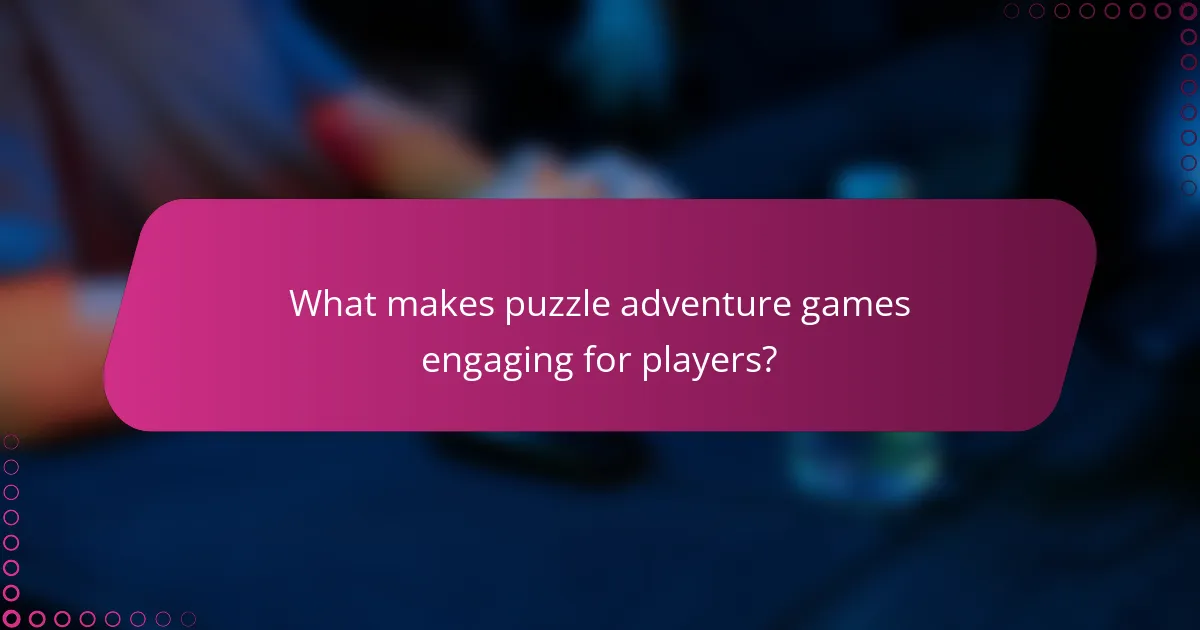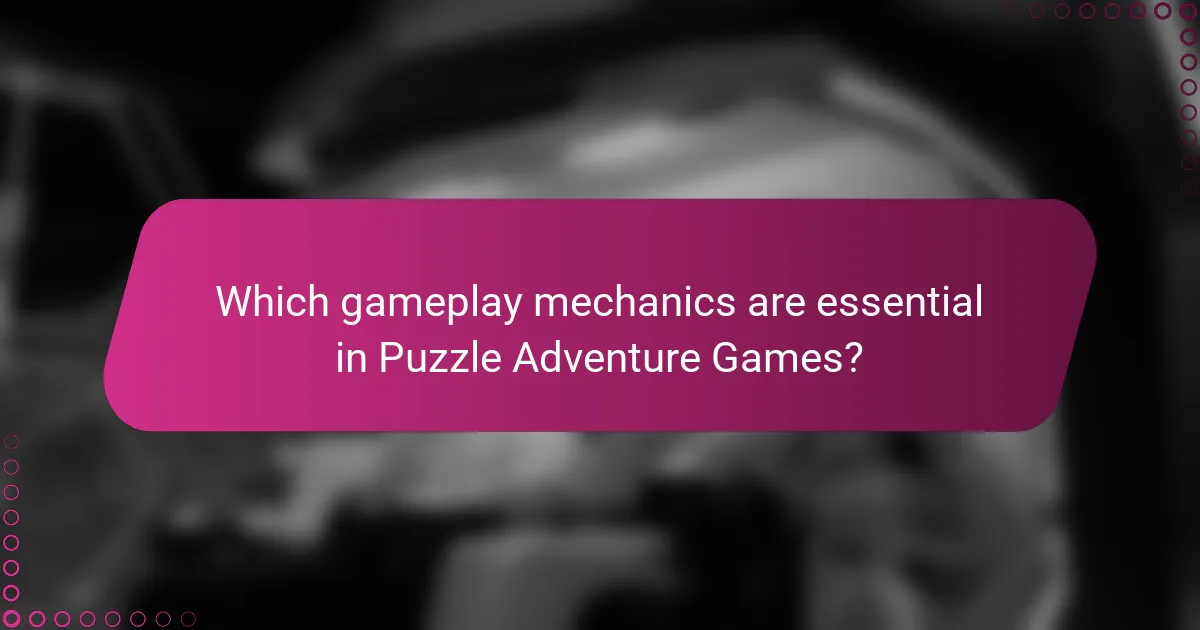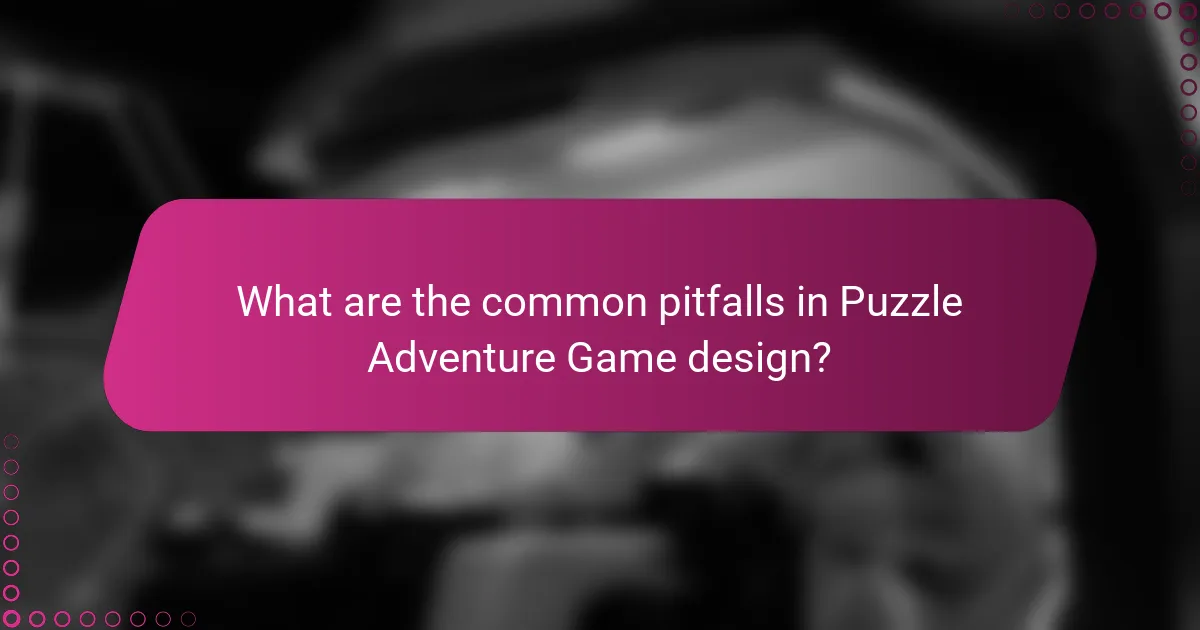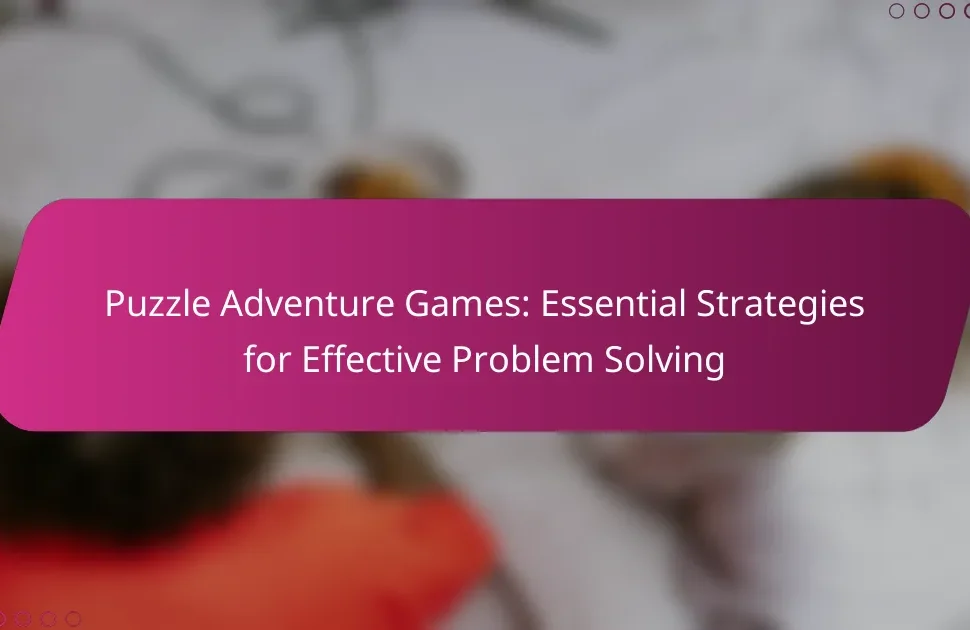Puzzle adventure games offer a unique blend of challenge and enjoyment, engaging players through intricate puzzles and immersive narratives. Essential gameplay mechanics include problem-solving, exploration, and narrative integration. Player demographics influence game design, shaping preferences for difficulty and enjoyment. Popular platforms such as PC, consoles, and mobile devices provide diverse experiences, while developers balance accessibility and challenge to enhance player satisfaction.

What makes Puzzle Adventure Games engaging for players?
Puzzle adventure games engage players through a blend of challenging puzzles and immersive storytelling. The balance between difficulty and satisfaction keeps players invested. Unique narrative elements enhance emotional connections, while varied gameplay mechanics cater to diverse preferences. Engaging visuals and audio further enrich the experience, making players feel part of the adventure.
How does challenge enhance the gaming experience?
Challenge enhances the gaming experience by fostering engagement and satisfaction. In puzzle adventure games, players face obstacles that require critical thinking and problem-solving skills. This balance of challenge and enjoyment keeps players motivated and immersed in the game world. Successfully overcoming challenges leads to a sense of achievement, reinforcing positive emotions. Additionally, well-designed difficulty curves ensure that players remain challenged without feeling frustrated, enhancing overall gameplay enjoyment.
What role does story play in player immersion?
Story significantly enhances player immersion in puzzle adventure games by creating emotional connections and driving engagement. A compelling narrative motivates players to solve challenges, as they become invested in the characters and plot. The integration of story elements, such as character backstories and environmental storytelling, enriches gameplay by providing context and meaning to puzzles. This relationship between story and gameplay fosters a deeper sense of accomplishment as players navigate through challenges while unraveling the narrative. Ultimately, a well-crafted story transforms gameplay into a memorable experience, reinforcing the enjoyment of overcoming obstacles.

Which gameplay mechanics are essential in Puzzle Adventure Games?
Essential gameplay mechanics in Puzzle Adventure Games include problem-solving, exploration, and narrative integration. These elements create a balanced experience that challenges players while maintaining enjoyment.
Problem-solving mechanics require players to engage with puzzles that vary in complexity, enhancing cognitive skills. Exploration mechanics encourage players to navigate diverse environments, uncovering secrets and progressing through the story. Narrative integration connects puzzles to the storyline, enriching player immersion and emotional investment.
Additionally, feedback systems provide players with immediate responses to their actions, reinforcing learning and progression. This combination of mechanics ensures a rewarding gameplay experience that keeps players engaged.
How do puzzles integrate with exploration elements?
Puzzle adventure games integrate exploration elements by creating immersive environments that challenge players while encouraging discovery. The puzzles often require players to interact with their surroundings, fostering a sense of adventure. This balance enhances enjoyment and keeps players engaged. Unique attributes like narrative depth and environmental storytelling further enrich the experience, making exploration feel rewarding. As a result, players are motivated to solve puzzles, uncover secrets, and progress through the game world.
What types of challenges are commonly found in these games?
Puzzle adventure games commonly feature challenges such as complex puzzles, time constraints, resource management, enemy encounters, and environmental obstacles. These challenges balance difficulty with enjoyment, enhancing player engagement and satisfaction. Players often face unique attributes like narrative-driven puzzles that require critical thinking and creativity.

How do player demographics influence game design in different regions?
Player demographics significantly influence game design in various regions by shaping preferences and expectations. Cultural factors, age groups, and gaming habits dictate the level of challenge and enjoyment in puzzle adventure games. For example, younger players may prefer more dynamic and fast-paced puzzles, while older players might appreciate intricate storylines and slower gameplay. Regional trends also affect design choices, as some cultures favor cooperative gameplay, while others lean towards competitive elements. Understanding these demographic nuances allows developers to create engaging experiences tailored to specific audiences, enhancing both challenge and enjoyment.
What age groups are most attracted to Puzzle Adventure Games?
Puzzle adventure games attract a diverse range of age groups, primarily appealing to players aged 18 to 34. This demographic enjoys the balance of challenge and enjoyment these games offer. Additionally, players aged 35 to 54 also show significant interest, often seeking engaging narratives and problem-solving elements. The unique attribute of puzzle adventure games is their ability to cater to varying skill levels, making them accessible to younger and older audiences alike. As a result, these games maintain a broad appeal across different age segments.
How do cultural preferences shape gameplay experiences?
Cultural preferences significantly influence gameplay experiences in puzzle adventure games by shaping player expectations and engagement. Different cultures prioritize various aspects of challenge and enjoyment, affecting game design and mechanics.
For instance, Eastern cultures may value narrative depth and character development, while Western audiences might prefer fast-paced action and immediate gratification. This divergence leads developers to tailor experiences that resonate with specific cultural backgrounds.
Moreover, cultural norms impact problem-solving approaches. Players from collectivist societies often collaborate, while individualistic cultures may emphasize personal achievement. This can lead to variations in gameplay mechanics, such as cooperative puzzles versus competitive challenges.
Ultimately, understanding these cultural preferences allows developers to create more inclusive and engaging puzzle adventure games that cater to diverse audiences.

What are the most popular platforms for Puzzle Adventure Games?
The most popular platforms for Puzzle Adventure Games include PC, consoles, and mobile devices. These platforms offer diverse gameplay experiences and accessibility for players.
PC platforms like Steam provide a vast library of puzzle adventure titles, often featuring intricate narratives and complex puzzles. Consoles such as PlayStation and Xbox also host popular games, enhancing the experience with advanced graphics and controls. Mobile devices, including smartphones and tablets, cater to casual gamers with user-friendly interfaces and quick gameplay sessions.
Each platform has unique attributes, such as the extensive game selection on PC, the immersive experience on consoles, and the convenience of mobile gaming. This variety ensures that players can find puzzle adventure games that suit their preferences and play styles.
How do mobile games compare to console and PC versions?
Mobile games offer portability and accessibility, while console and PC versions provide superior graphics and complex controls. Puzzle adventure games thrive on touch interfaces in mobile formats, enhancing user engagement. In contrast, consoles and PCs enable deeper gameplay mechanics through advanced processing power. Mobile versions typically feature shorter sessions, catering to casual players, whereas console and PC games often deliver immersive experiences with longer narratives. Overall, the choice depends on player preferences for convenience or depth in gameplay.
What impact do online communities have on gameplay enjoyment?
Online communities significantly enhance gameplay enjoyment in puzzle adventure games. They provide players with shared experiences, strategies, and support, which can alleviate frustration from challenging puzzles. Engaging with others fosters a sense of belonging, encouraging collaboration and competition. This interaction often leads to increased motivation and prolonged engagement, as players share solutions and celebrate achievements together. Additionally, feedback from these communities can guide developers in refining game mechanics, ultimately improving the overall gaming experience.

How do developers balance difficulty and accessibility?
Developers balance difficulty and accessibility by incorporating adjustable difficulty levels and intuitive controls. This approach ensures players of varying skill levels can engage with the game.
Game designers often use playtesting to gauge player responses and adjust challenges accordingly. Feedback helps refine puzzles, making them rewarding yet achievable.
Accessibility features, such as hints or adjustable timers, cater to diverse player needs. These elements enhance enjoyment without compromising the game’s core challenge.
Ultimately, the goal is to create a fulfilling experience where players feel accomplished, regardless of their proficiency.
What strategies are used to cater to both casual and hardcore gamers?
Puzzle adventure games utilize diverse strategies to engage both casual and hardcore gamers effectively. These strategies include adjustable difficulty levels, which allow players to tailor their experience, and rich narratives that captivate a broad audience.
Incorporating varied puzzle types caters to different skill sets, ensuring both groups find challenges that suit their preferences. Additionally, offering cooperative gameplay fosters social interaction, appealing to casual gamers while still providing depth for hardcore players.
Regular updates and community engagement maintain interest, encouraging players to return. These elements create a balanced environment where enjoyment and challenge coexist, enhancing overall gameplay satisfaction.
How does player feedback shape game updates and expansions?
Player feedback significantly influences game updates and expansions by guiding developers in enhancing gameplay. This input helps identify balance issues between challenge and enjoyment, ensuring puzzles remain engaging. Developers analyze player data to adjust difficulty levels, introduce new features, and refine mechanics. Continuous engagement with player communities fosters a collaborative environment, leading to more satisfying gaming experiences. This iterative process enhances player retention and satisfaction, ultimately benefiting the game’s longevity.

What unique features differentiate standout Puzzle Adventure Games?
Unique features that differentiate standout Puzzle Adventure Games include engaging narratives, intricate puzzles, and immersive environments. These games often blend storytelling with problem-solving, enhancing player experience. Unique attributes like diverse character interactions and adaptive difficulty levels further elevate gameplay. Rare features such as innovative mechanics or artistic styles can make certain titles memorable.
How does art style influence player perception and enjoyment?
Art style significantly influences player perception and enjoyment in puzzle adventure games by shaping the overall atmosphere and emotional engagement. A unique art style can enhance immersion, making players feel more connected to the game world. For example, a whimsical, colorful aesthetic may evoke feelings of joy and curiosity, while a darker, more realistic style can create tension and challenge.
Players often associate specific art styles with particular gameplay experiences. A vibrant, cartoonish design may lead to a perception of lightheartedness, encouraging exploration and experimentation. In contrast, a minimalist or abstract style might focus players on solving puzzles, enhancing the sense of challenge.
Moreover, art style can impact player enjoyment through visual storytelling. Engaging visual narratives can deepen emotional connections, making successes and failures more meaningful. This connection can increase overall satisfaction, as players feel their achievements are part of a larger story.
Ultimately, the right art style can balance challenge and enjoyment, enhancing player experience in puzzle adventure games.
What innovative mechanics have emerged in recent titles?
Innovative mechanics in recent puzzle adventure games include environmental manipulation, narrative-driven puzzles, and cooperative gameplay. These mechanics enhance player engagement and challenge while maintaining enjoyment.
Environmental manipulation allows players to interact with surroundings creatively, solving puzzles in unique ways. Narrative-driven puzzles integrate storytelling, making challenges feel more meaningful. Cooperative gameplay encourages teamwork, fostering social interaction and shared problem-solving experiences.
These mechanics reflect a trend towards immersive gameplay that balances challenge and enjoyment.

What are the common pitfalls in Puzzle Adventure Game design?
Common pitfalls in puzzle adventure game design include overly complex puzzles, lack of clear guidance, inconsistent difficulty levels, and insufficient player feedback. These issues can frustrate players and diminish enjoyment.
Overly complex puzzles can lead to player disengagement. If puzzles are too difficult or require obscure knowledge, players may feel lost. Lack of clear guidance can further exacerbate this issue, leaving players unsure of how to progress.
Inconsistent difficulty levels can disrupt the flow of gameplay. A sudden spike in challenge can alienate players who may have been enjoying a more moderate pace. Insufficient player feedback can result in confusion about whether actions are correct or productive, leading to frustration.
Addressing these pitfalls can enhance player experience, ensuring a balance between challenge and enjoyment in puzzle adventure games.
How can developers avoid frustrating players with challenging puzzles?
Developers can avoid frustrating players with challenging puzzles by ensuring a balanced difficulty curve. Gradually increasing complexity keeps players engaged without overwhelming them.
Incorporating hints or adjustable difficulty settings allows players to tailor their experience. Testing puzzles with diverse player groups helps identify potential frustrations.
Providing clear feedback on player actions enhances understanding and reduces confusion. Using intuitive design and familiar mechanics can make puzzles more accessible.
Regular updates based on player feedback can refine puzzle elements to maintain enjoyment. Engaging players through narrative context can also motivate them to solve challenges.
What mistakes should be avoided to ensure player retention?
To ensure player retention in puzzle adventure games, avoid frustrating difficulty spikes, unclear objectives, and repetitive gameplay. These mistakes can diminish enjoyment and lead to player disengagement.
1. Maintain a balanced difficulty curve to keep players challenged yet engaged.
2. Clearly communicate goals and objectives to prevent confusion.
3. Introduce varied gameplay mechanics to sustain interest over time.
4. Solicit player feedback to identify pain points and improve the experience.

How can players optimize their experience in Puzzle Adventure Games?
Players can optimize their experience in Puzzle Adventure Games by balancing challenge and enjoyment through strategic gameplay. Focus on understanding game mechanics to solve puzzles efficiently. Utilize hints sparingly to maintain engagement without frustration. Collaborate with others to gain new perspectives on challenging puzzles. Regularly practice to enhance problem-solving skills, which improves overall enjoyment. Experiment with different strategies and approaches to discover what works best for individual play styles.
What are the best strategies for solving complex puzzles?
To solve complex puzzles effectively, players should employ strategies that enhance both challenge and enjoyment. First, break down the puzzle into smaller, manageable sections. This approach helps to identify patterns and connections. Next, utilize trial and error; experimenting with different solutions can lead to breakthroughs. Additionally, collaborating with other players can provide fresh perspectives and insights. Lastly, maintain a positive mindset to keep motivation high, as persistence often leads to success in challenging puzzles.
How can players leverage community resources for enhanced gameplay?
Players can enhance their gameplay by utilizing community resources such as forums, guides, and social media groups. These platforms offer strategies, tips, and support from experienced players, fostering collaboration and shared knowledge. Engaging with the community can lead to discovering unique gameplay techniques and overcoming challenging puzzles. Additionally, players can find rare items or unlock achievements through shared experiences and insights, enriching their overall gaming experience.




